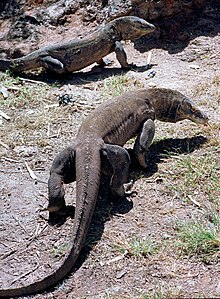Varanids
| Varanids Temporal range: Late Cretaceous - Holocene, 80–0 Ma |
|
|---|---|
 |
|
| Komodo dragon (Varanus komodoensis) | |
 |
|
| Savannah monitor (Varanus exanthematicus) | |
| Scientific classification | |
| Kingdom: | Animalia |
| Phylum: | Chordata |
| Class: | Reptilia |
| Order: | Squamata |
| Superfamily: | Varanoidea |
| Family: |
Varanidae Merrem, 1820 |
| Genera | |
Varanidae is a family of lizards in the superfamily Varanoidea. The family, a group of carnivorous and frugivorous lizards, includes the extinct Megalania (the largest known lizard), the Komodo dragon (the largest living lizard), and the crocodile monitor. Varanidae also contains the living genus Varanus and a number of extinct taxa. Their closest living relatives are the anguid and helodermatid lizards.
Varanidae was defined by Estes, de Queiroz and Gauthier (1988) as the clade containing the most recent common ancestor of Lanthanotus and Varanus and all of its descendants. A similar definition was formulated by Conrad et al. (2008), who defined Varanidae as the clade containing Varanus varius, Lanthanotus borneensis, and all descendants of their last common ancestor. Using one of these definitions leads to the inclusion of the earless monitor lizard (Lanthanotus borneensis) in the family Varanidae.
Lee (1997) created a different definition of Varanidae, defining it as the clade containing Varanus and all taxa more closely related to Varanus than to Lanthanotus; this definition explicitly excludes the earless monitor lizard from Varanidae. Whether Lanthanotus borneensis is included in or excluded from Varanidae depends on the author: for example, Vidal et al. (2012) classify the earless monitor lizard as a member of a separate family Lanthanotidae, while Gauthier et al. (2012) classify it as a member of Varanidae.
Genera usually included in Varanidae (under subfamily Varaninae according to Conrad et al., 2008)):
...
Wikipedia
